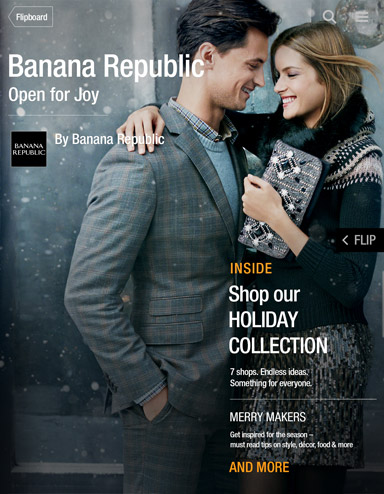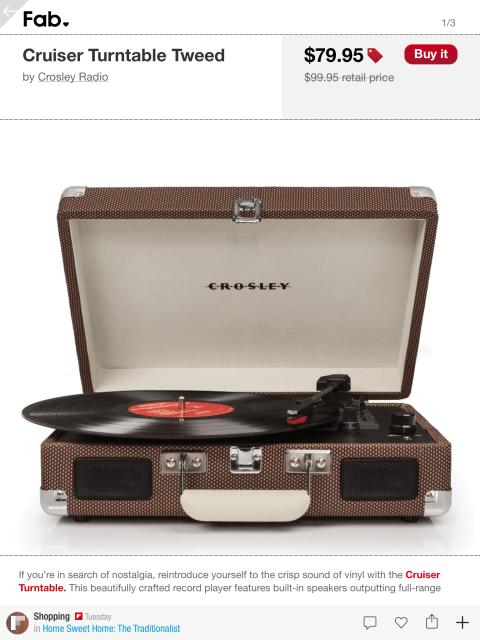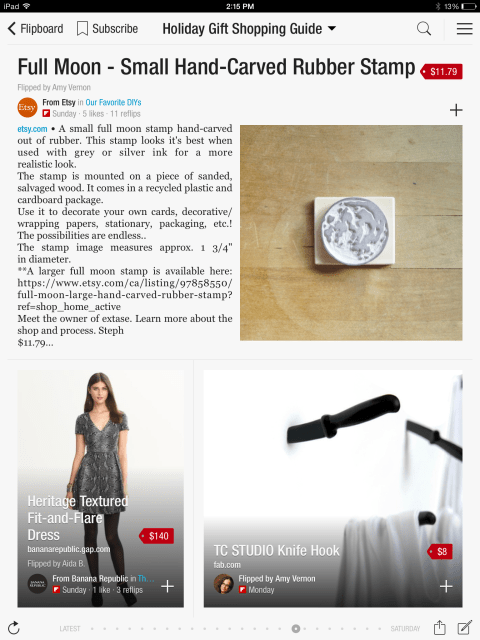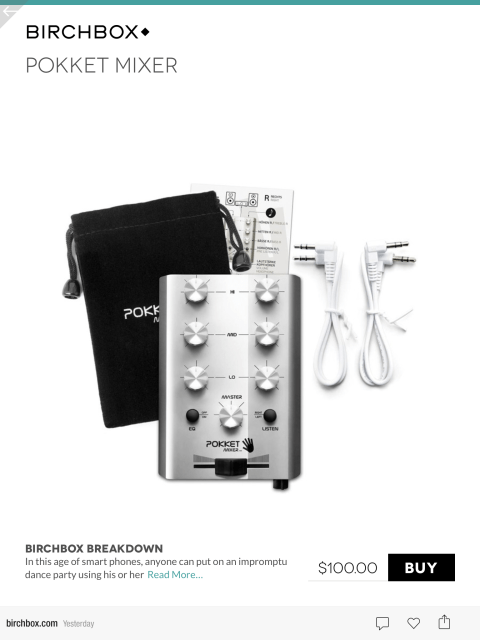 Flipboard is inching into Pinterest’s territory today with the launch of a new “shopping” category which allows e-commerce brands turn their online stores into flippable, shoppable catalogs, complete with pricing info and big, red “buy” buttons for the items they sell. Meanwhile, everyday users are also now able to build catalogs of their own, using the updated “flip.it” button for web browsers. The company has several new launch partners for its new catalogs, including eBay, Banana Republic, Fab, Birchbox, and ModCloth, as well existing partners like Etsy and Levi’s.
Flipboard is inching into Pinterest’s territory today with the launch of a new “shopping” category which allows e-commerce brands turn their online stores into flippable, shoppable catalogs, complete with pricing info and big, red “buy” buttons for the items they sell. Meanwhile, everyday users are also now able to build catalogs of their own, using the updated “flip.it” button for web browsers. The company has several new launch partners for its new catalogs, including eBay, Banana Republic, Fab, Birchbox, and ModCloth, as well existing partners like Etsy and Levi’s.
Flipboard’s Catalogs Look More Like Print, Less Like Online Stores
These brands worked with Flipboard’s team who have turned their websites into custom catalogs, where the formatting has been modified to be cleaner and more minimalistic – basically, more like it would appear if it were a print catalog as opposed to a cluttered e-commerce website. The product images are large. You can zoom in and out on the items displayed, and the item price tag is prominently displayed on each page.
 In addition, these catalogs can contain a mixture of products and editorial, or brands can choose to organize their product lines into separate, smaller magazines, like those featuring just winter apparel, “plaids,” or even holiday gift guides, if they choose.
In addition, these catalogs can contain a mixture of products and editorial, or brands can choose to organize their product lines into separate, smaller magazines, like those featuring just winter apparel, “plaids,” or even holiday gift guides, if they choose.
Also at launch, the new top-level “Shopping” category in Flipboard will include magazines from celebratory curators like fashion designer Cynthia Rowley, singer Sara Evans, chef Daniel Boulud and actress Alyssa Milano, who have built magazines containing their favorite products.
The brands who want to get in on the catalog action will have to reach out to Flipboard directly to get that process – there aren’t DIY tools like Pinterest offers to e-commerce businesses, who can simply mark up their websites with meta tags in order to have their products and pricing displayed on the social pinboarding site when shared by users.
Flipboard CEO Mike McCue explains that the catalog push with brand partners is similar to the work the company did to bring online publishers into the social magazine in the past.
“You can see the parallel here with Flipboard Pages where we paginate article content. We did that with at first with about eight publishers, and over time, we’ve added hundreds to the mix,” he says. “We’re going to do the same thing on the retail side.” The Flipboard team does all the templating and formatting by hand for the catalogs, which takes a couple of weeks, says McCue. But this process can be speed up over time.
 The company expects to bring one or two more retailers on before the holidays, and plans to have anywhere from 10 to 20 more added within Q1 2014.
The company expects to bring one or two more retailers on before the holidays, and plans to have anywhere from 10 to 20 more added within Q1 2014.
McCue says the company was inspired by trends it saw both within its own user base, as well as with its advertising partners, like Levi’s. Users had begun to build out their own product catalogs using the company’s bookmarklet, while Levi’s was already pointing users to a specially curated magazine it built itself.
“Flip.it” Button Grabs Pricing From Web Pages, Gets Smarter Over Time
To cater to the needs of the former, the company also updated its Flipboard bookmarklet today to allow users to capture product category and price when clipping items from the web. The tool will scrape the text from the web page, or when it’s not able to do so, users can select the category manually or type in the price themselves. By doing so, over time they’ll teach the system about where product information and prices are found on that particular website.
McCue says that the company will not be monetizing these catalogs through an affiliate model, though in time, that might make sense to offer something like that to Flipboard end users. Instead, brands building catalogs will buy ads that point to their curated catalogs. While the catalogs themselves have only just launched, so there aren’t price points to speak of yet, other ads in Flipboard have been doing very well, says McCue.
Ads Rates To Rival Print, Says Company
“At a high level, the economics for ad deals on Flipboard near print, as opposed to digital CPMs – which has always been a goal of ours,” he says. “This kind of brand advertising sells for about the same as what it sells for in print pages in Vanity Fair.” McCue adds that, on average, Flipboard sees around 3% clickthroughs on its ads, though some have been as high as 12% in the past. And once people tap into an ad which takes them to a magazine, 10% of the time they end up subscribing, often exploring between 30 or 40 pages deep.
 Though catalogs initially seem to be a competitive stance against Pinterest, McCue feels differently, saying that he doesn’t see what they’re doing versus what Pinterest does as mutually exclusive.
Though catalogs initially seem to be a competitive stance against Pinterest, McCue feels differently, saying that he doesn’t see what they’re doing versus what Pinterest does as mutually exclusive.
“The world is big enough for these to exist side by side,” he says, noting also that in time, Pinterest and Flipboard will actually work more closely together.
That is, “being able to pin something from Flipboard onto one of your pinboards and vice versa – being able to take something from your pinboards and putting into a Flipboard magazine,” he says.
Flipboard still declines to discuss revenue, but McCue would say the company is now “generating millions of dollars for our publishing partners,” he says. “People are making money, they’re happy.”